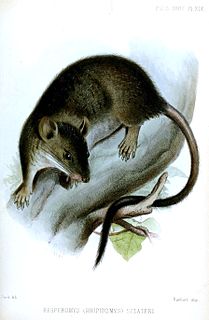Cerradomys marinhus, also known as Marinho's rice rat, is a rodent species from South America. It is found in Minas Gerais, Brazil. It was formerly known as Oryzomys marinhus, but was transferred to the new genus Cerradomys in 2006.

Rhipidomys is a genus of rodents in the family Cricetidae, The following 24 species of climbing mouse species are currently recognised:
Nesoryzomys indefessus, also known as the Santa Cruz nesoryzomys or Indefatigable Galápagos mouse, is a rodent of the genus Nesoryzomys of family Cricetidae from Galápagos Islands of Ecuador. It contains two subspecies: one formerly lived on Santa Cruz Island, but is now extinct, probably due to the introduction of black rats; and another that is still alive on Fernandina Island. The two are sometimes considered to be different species.
The Colombian forest mouse is a species of rodent in the family Cricetidae. Some authorities consider it to be the only species in the genus Chilomys, while others accept Chilomys fumeus as being a valid species, and it may form part of a species complex. It is found in Colombia, Ecuador, and Venezuela.
Neacomys pictus, also known as the painted neacomys or painted bristly mouse, is a species of rodent in the genus Neacomys of family Cricetidae. It is found only in Panama.
Oreoryzomys balneator, also known as the Peruvian rice rat or Ecuadoran oryzomys, is a species of rodent in the tribe Oryzomyini of family Cricetidae. It is found in Ecuador and northern Peru in cloud forest at elevations from 1500 to 1800 m. It is the only species in the genus Oreoryzomys, which was included in Oryzomys until 2006. The genus name Oreoryzomys is a combination of ορος the Greek word for "mountain" with the old genus name Oryzomys and refers to the mountainous habitat of O. balneator. Recent research suggests that O. balneator is not closely related to Oryzomys, but instead is probably related to Microryzomys within a clade also including Neacomys and Oligoryzomys.

Euryoryzomys lamia, also known as the buffy-sided oryzomys or monster rice rat, is a species of rodent in the family Cricetidae. It is found only in central Brazil, where it lives in forest enclaves within the cerrado. The species' known altitudinal range is from 700 to 900 m. The main threats to its survival are the destruction and fragmentation of its forest habitat.
Handleyomys rhabdops, also known as the highland oryzomys or striped rice rat, is a species of rodent in the genus Handleyomys of family Cricetidae. It is nocturnal and is found in Guatemala and Mexico in montane forest at elevations from 1250 to 3250 m.
The southern climbing mouse is a species of rodent in the family Cricetidae. It is found in Argentina and Bolivia in forested valleys and on slopes on the eastern side of the Andes Mountains.
The Cauca climbing mouse is a species of arboreal rodent in the family Cricetidae. It is endemic to Colombia, where it is found in montane forest at elevations from 2200 to 3500 m.
Coues's climbing mouse is a species of rodent in the family Cricetidae. It is found in Colombia, Ecuador, Peru, Trinidad and Tobago, and Venezuela. It is named in honour of the American zoologist Elliott Coues who studied birds and small mammals.
The buff-bellied climbing mouse is a species of rodent in the family Cricetidae. It is found in Colombia and Venezuela.
The broad-footed climbing mouse is a species of rodent in the family Cricetidae. It is found in Colombia, Ecuador, Panama and Peru.
The Venezuelan climbing mouse is a species of rodent in the family Cricetidae. It is found in Colombia, Tobago, and Venezuela.
The charming climbing mouse is a species of nocturnal rodent in the family Cricetidae. It endemic to Venezuela.
Wetzel's climbing mouse is a species of rodent in the family Cricetidae. It is endemic to Venezuela.

The Atlantic Forest climbing mouse is an arboreal rodent species in the family Cricetidae from South America. It is found in the Atlantic Forest of southeastern Brazil at elevations from sea level to 1500 m. Its karyotype is 2n = 44, FN = 74–80.
The cerrado climbing mouse or long-tailed rhipidomys is an arboreal rodent species in the family Cricetidae from South America. It is found in primary or secondary forests of the cerrado and caatinga in central and eastern Brazil, and has also been seen in the Atlantic Forest. Its karyotype is 2n = 44, FN = 48-52. They are nocturnal animals and can be found in both tree canopies and on the ground.
Hylaeamys tatei, also known as Tate's oryzomys or Tate's rice rat, is a South American rodent species of the family Cricetidae. It is known only from the eastern foothills of the Andes in central Ecuador, where it has been found at elevations from 1130 to 1520 m. H. tatei is most closely related to H. yunganus, which occurs throughout Amazonia. The species is found in tropical rainforest and is terrestrial and probably nocturnal. It is named after American zoologist George Henry Hamilton Tate.
The Peruvian climbing mouse or lesser Peruvian rhipidomys, is a South American species of rodent in the family Cricetidae. It is endemic to the eastern slopes of the Andes in central Peru, where it is found at altitudes from 700 to 1,800 metres. The species is nocturnal and arboreal, and lives in lower montane forest and cloud forest. It is threatened by forest clearance for agriculture and coca cultivation but is listed as a "least-concern species" by the International Union for Conservation of Nature.



